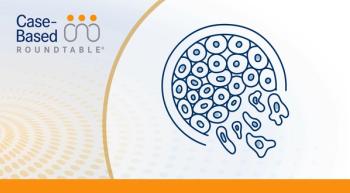
Selecting a Treatment Regimen in R/R Multiple Myeloma
Ravi Vij, MD, MBA:Patients who are older certainly have more challenging circumstances in terms of deciding on choice of treatment. We have discussed that 3-drug regimens have become the norm. The fact, however, is that for some people we need to improvise treatments because they cannot tolerate 3-drug regimens. In that regard, we know that giving these patients sometimes just a 2-drug regimen of ixazomib and dexamethasone may be sufficient to produce a response and maintain quality of life. In other cases, we sometimes use single agents like daratumumab as well. In this patient with a performance status of 2, the 3-drug regimen seemed to be an appropriate initial choice. It would, I think, provide the right balance in terms of improving efficacy, depth of response, and progression-free survival, while still maintaining quality of life.
Ixazomib is a drug that adds little to the toxicity of lenalidomide and dexamethasone. It is a drug that certainly has some potential to cause neuropathy and rashes. Like any drug we use for myeloma, some element of fatigue is often reported. It doesn’t add much to the hematological toxicity of lenalidomide and dexamethasone. So I think that in an older population, this 3-drug regimen of ixazomib/lenalidomide/dexamethasone is not much more toxic than what you would usually expect with lenalidomide and dexamethasone.
The choice of treatment for patients with relapsed/refractory [R/R] disease is one that requires taking into account a number of factors, which include patient-related factors, disease-related factors, and things of the nature of the social environment of a patient. Patient-related factors, in addition to the age, include their comorbidities, their performance status, and their renal function. For disease-related factors, the aggressiveness of the disease and the cytogenetics of the tumor play a role in our decision making. And then, does the patient have a caregiver? How far away does the patient live? What is the patient’s own desire? Is he able to afford co-pays for oral medicines?
These all factor into our choice of treatment. The patients who are being followed closely by doctors, especially when they’re seeking a second-line option are often picked up when the disease is just showing evidence of what we call a biochemical progression. They’re often not symptomatic. And in that scenario, it is often debated whether changing treatment is even necessary. However, with the abundance of options that we have now, we certainly have probably started treating patients earlier than we would have in the past.
The things that we often do at the time of first relapse in a patient who has otherwise a biochemical progression is to get a PET [positron emission tomography] scan and a bone marrow biopsy, to see if we can get a better sense of the bulk of disease. In a patient who has biochemical progression and has a PET scan, I personally treat that patient as if he or she has true symptomatic progression with the evolution of new CRAB [calcium elevated, renal failure, anemia, bone lesions] criteria that the audience is familiar with here, in terms of its relationship to multiple myeloma.
For patients who have slow progression of their disease, I’m often comfortable using a 3-drug regimen like elotuzumab/Revlimid/Decadron or ixazomib/lenalidomide/dexamethasone. And these regimens are usually well tolerated. They provide a good balance between toxicity and efficacy. Also, convenience favors oral regimens.
So the regimen of elotuzumab/lenalidomide/dexamethasone, though a regimen that includes an IV [intravenous] drug, is usually well tolerated. And again, for patients with biochemical progression, the regimen offers a good choice. In patients who have more rapid progression of their disease, who are more symptomatic and otherwise healthy, I think that often we use 3-drug regimens like daratumumab with either lenalidomide or pomalidomide and dexamethasone, sometimes pairing the daratumumab with bortezomib and dexamethasone. The patients who have gotten daratumumab, or in some cases, even before daratumumab is used, the use of a Kyprolis-based 3-drug regimen is also an option. In that regard, once again, Kyprolis with lenalidomide/dexamethasone, pomalidomide and dexamethasone, or Cytoxan and dexamethasone, for that matter, are popular regimens.
Transcript edited for clarity.
Case: 75-Year-Old Man With Symptomatic R/R Multiple Myeloma
January 2015
- A 75-year-old man was diagnosed with multiple myeloma; R-ISS stage I
- PMH: hypertension; coronary artery disease post stent placement
- Patient was treated with lenalidomide + dexamethasone for 9 months; transplant-ineligible due to age and performance status
- Patient achieved a VGPR, discontinued treatment thereafter due to patient request
September 2018
- On routine follow-up 3 years later, patient presents with new-onset back pain and generalized fatigue
- Imaging: multiple new lytic lesions with compression fractures
- Laboratory results:
- Hb, 10.7 g/dL
- Ca2+, 9.3 mg/dL
- Creatinine, 1.1 mg/dL
- M-protein, 3.2 g/dL
- Cytogenetics/FISH: del (17p) discovered at relapse
- ECOG PS: 2







































